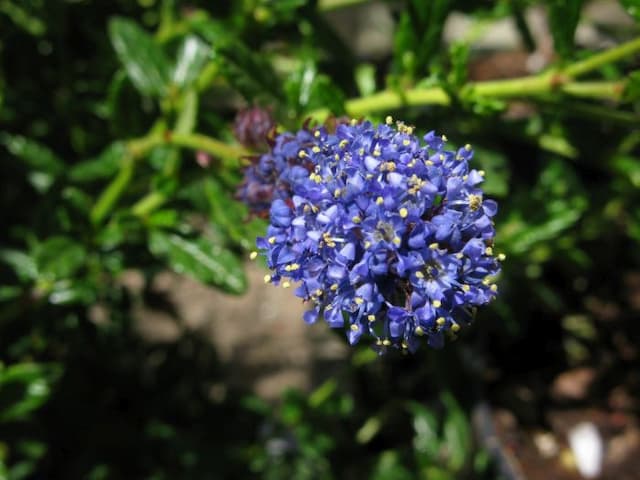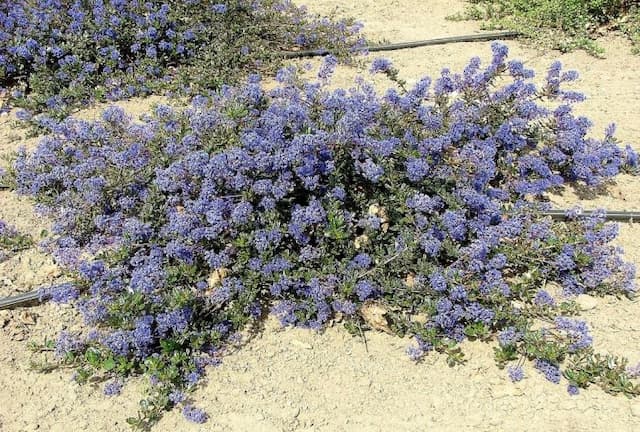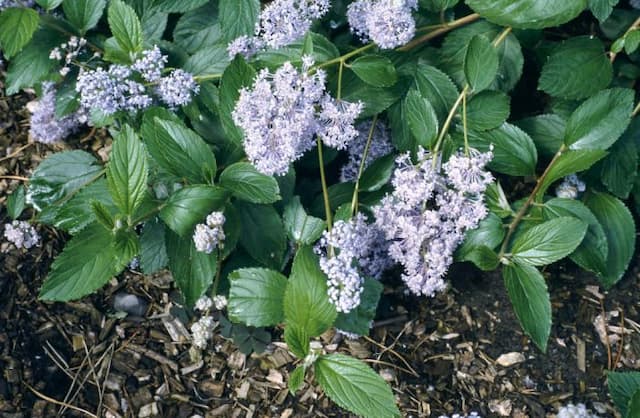Ceanothus 'Pin Cushion'

ABOUT
Ceanothus 'Pin Cushion' is characterized by its dense, rounded habit that presents a lush appearance, creating a puffy silhouette much like a pin cushion. This evergreen shrub boasts small, glossy green leaves that remain on the plant year-round, providing a constant display of foliage. The leaves are oval to oblong in shape and are held tightly together, giving the impression of a well-manicured, compact surface. The most striking feature of Ceanothus 'Pin Cushion' is its abundant flowers. The blossoms emerge in clusters that stand out against the dark green backdrop of the foliage. The flowers are typically a rich blue hue, deep and vibrant, and they cover the shrub so profusely that during peak bloom, the foliage almost disappears beneath the floral display. These blooms are not only visually appealing but they also attract a variety of pollinators such as bees and butterflies, adding to the dynamic nature of the plant. After flowering, the plant produces small, inconspicuous seed capsules that blend into the foliage. The overall texture of Ceanothus 'Pin Cushion' is fine yet dense, contributing to its use as a focal point in garden designs where structure and year-round interest are desired. Despite the omission of specific size details, this description encapsulates the essence of the plant's visual appearance and the ornamental qualities it brings to a landscape.
About this plant
 Names
NamesFamily
Rhamnaceae
Synonyms
California Lilac, Blueblossom, Wild Lilac
Common names
Ceanothus 'Pin Cushion'.
 Toxicity
ToxicityTo humans
California lilac, specifically the 'Pin Cushion' variety, is not known to be toxic to humans. There are no common reports of poisoning or toxic reactions in humans from ingestion or contact with California lilac plants. However, as with many plants, individual allergic reactions or sensitivities are possible.
To pets
California lilac is generally considered non-toxic to pets. Both dogs and cats are unlikely to suffer from poisoning if they ingest parts of the California lilac 'Pin Cushion' plant. It should be noted, however, that individual animals can have unique sensitivities, and that consuming large quantities of non-food plants can cause digestive upset or other non-toxic reactions in some pets.
 Characteristics
CharacteristicsLife cycle
Perennials
Foliage type
Evergreen
Color of leaves
Dark green
Flower color
Blue
Height
2 feet 0.61 meters
Spread
2 feet 0.61 meters
Plant type
Shrub
Hardiness zones
7
Native area
North America
Benefits
 General Benefits
General Benefits- Attracts Pollinators: The plant is known for attracting bees and butterflies, thus supporting local ecosystems.
- Drought Tolerance: California Lilac can withstand dry periods, making it suitable for water-wise gardens.
- Low Maintenance: Requires minimal care once established, providing a hassle-free addition to the landscape.
- Aesthetic Appeal: The vibrant blue flowers and evergreen foliage add color and structure to garden designs.
- Erosion Control: The plant's root system helps stabilize slopes, preventing soil erosion.
- Wildlife Habitat: Provides shelter and food for various birds and insects, contributing to biodiversity.
- Fast Growth: California Lilac tends to grow quickly, which is ideal for gardeners looking to establish a plant relatively soon.
- Fragrance: The blooms emit a pleasant scent that can enhance the sensory experience of a garden.
 Medical Properties
Medical PropertiesThis plant is not used for medical purposes.
 Air-purifying Qualities
Air-purifying QualitiesThis plant is not specifically known for air purifying qualities.
 Other Uses
Other Uses- Ceanothus, also known as California lilac, can be used to create a natural dye. The flowers, especially from darker varieties, can impart hues of green or blue to fabrics when used in traditional dyeing processes.
- The wood of California lilac is quite hard and has been historically used to make small wooden objects such as tool handles or pipes, showcasing its durability and fine grain when polished.
- Due to its dense habit, California lilac can provide shelter for small wildlife, such as birds or beneficial insects, within a garden setting.
- When planted as a hedge, California lilac serves as a windbreak, protecting more sensitive plants and reducing soil erosion.
- The plant's extensive root system makes it excellent for stabilizing slopes and banks, preventing landslides and controlling erosion in vulnerable areas.
- California lilac can be used in permaculture designs as a nitrogen-fixing plant, improving soil fertility over time and aiding the growth of neighboring plants.
- The dense foliage can offer privacy when planted as a screen or living fence, blocking unwanted views and muffling noise.
- In floral arrangements, California lilac provides a burst of color and an attractive fragrance, often used as a filler to complement other blooms.
- The leaves of the plant can be used in compost as a green layer, contributing to the nitrogen content of the compost and accelerating the decomposition process.
- In areas prone to wildfires, California lilac can be strategically planted as part of a fire-resistant landscaping plan, as it is considered to have a higher moisture content and lower flammability rate.
Interesting Facts
 Feng Shui
Feng ShuiThe California Lilac is not used in Feng Shui practice.
 Zodiac Sign Compitability
Zodiac Sign CompitabilityThe California Lilac is not used in astrology practice.
 Plant Symbolism
Plant Symbolism- Hardiness: As a robust and resilient plant, the Ceanothus 'Pin Cushion', commonly known as California Lilac, represents the ability to persevere and thrive even in challenging conditions.
- Endurance: California Lilac's ability to withstand dry spells symbolizes enduring hard times with grace and strength.
- Revitalization: Its vibrant blue flowers are often associated with rejuvenation and a fresh start, embodying a sense of rebirth or new beginnings.
- Patriotism: The deep blue color of its blossoms can symbolize loyalty and patriotic pride, reminiscent of the blue found in the United States flag.
- Hope: The bright flowers of the California Lilac are also seen as a beacon of hope, suggesting optimism and anticipation for the future.
 Water
WaterCalifornia Lilac, commonly known as Ceanothus 'Pin Cushion', is drought-tolerant once established. During its first growing season, water it regularly to help establish a deep, extensive root system. Watering once a week with approximately 1-2 gallons is sufficient, depending on soil type and weather conditions. After it is established, reduce frequency, watering it every 2-3 weeks, and during the cooler seasons, even less. It's important not to overwater, as California Lilac is susceptible to root rot in wet conditions.
 Light
LightCalifornia Lilac thrives in full sun conditions, needing at least six hours of direct sunlight daily for optimal growth and flowering. It should be placed in a spot where it can receive unfiltered sunshine throughout the day. Partial shade can be tolerated but may result in fewer blooms and a less dense growth habit.
 Temperature
TemperatureCalifornia Lilac performs best in a range of temperatures, with ideal conditions between 60°F and 75°F. It can withstand minimum temperatures down to about 10°F, making it suitable for USDA zones 7 to 10. However, it's important to protect it from extreme cold and frost, as temperatures below this range can cause damage to the plant.
 Pruning
PruningPruning California Lilac is important to maintain its shape and encourage healthy growth. Prune immediately after flowering in late spring or early summer to remove spent blooms and shape the plant. Light pruning should be done annually, while more severe pruning for shape and size control is best done every few years, as the plant may not respond well to harsh pruning.
 Cleaning
CleaningAs needed
 Soil
SoilCalifornia Lilac 'Pin Cushion' thrives in well-draining soil with a slightly acidic to neutral pH between 5.5 and 7. A blend of regular potting mix with added perlite and a small amount of peat moss can create the ideal soil structure and acidity. This mix ensures proper drainage and aeration, preventing root rot.
 Repotting
RepottingCalifornia Lilac 'Pin Cushion' should be repotted approximately every two to three years to ensure it has enough room for growth and to refresh the soil. As they can be sensitive to root disturbance, repotting should be done carefully to minimize damage to the root system.
 Humidity & Misting
Humidity & MistingCalifornia Lilac 'Pin Cushion' is adapted to moderate humidity levels typical of its native environment. Optimal humidity ranges from 40% to 60%. It can tolerate lower humidity levels but might need additional moisture during extremely dry conditions.
 Suitable locations
Suitable locationsIndoor
Place in bright, indirect light; well-draining soil.
Outdoor
Full sun to partial shade; well-drained soil; shelter from wind.
Hardiness zone
7-10 USDA
 Life cycle
Life cycleThe life cycle of the Ceanothus 'Pin Cushion', commonly known as California lilac, begins with seed germination, which typically occurs in spring or early summer when conditions are favorable, requiring warmth and moisture. After germination, the seedling stage follows, where initial roots and shoots develop and the plant begins to establish itself. As the plant enters the vegetative growth stage, the California lilac develops a woody stem, mature leaves, and an extensive root system to support growth and prepare for flowering. The reproductive stage is marked by the California lilac producing dense clusters of small, blue or purple flowers, typically in mid-spring to early summer, which are pollinated by insects such as bees and butterflies. Following pollination, the plant produces dry, capsule-like fruits containing seeds, which are dispersed by wind, gravity, or wildlife, enabling the cycle to begin anew. The California lilac can remain in the mature phase for several years, flowering annually, until environmental conditions or other factors lead to its senescence and eventual death.
 Propogation
PropogationPropogation time
Spring-Early Summer
Ceanothus 'Blue Blossom', a popular Californian native shrub known for its attractive blue flowers, is often propagated through semi-hardwood cuttings. This method is typically done in late summer, after the new growth has partially matured and become slightly firm. To propagate by this method, a cutting of about 4 to 6 inches (10 to 15 centimeters) long is taken, cutting just below a node, as this is where the rooting hormones are most concentrated. The lower leaves are removed and the cut end is then dipped in rooting hormone powder to encourage root development. The cutting is then placed in a pot filled with a well-draining potting mix, and kept moist and in indirect light until roots have formed, which usually takes a few weeks to a couple of months. After rooting, the new plants can be gradually acclimatized to outdoor conditions and then planted in their permanent location.









